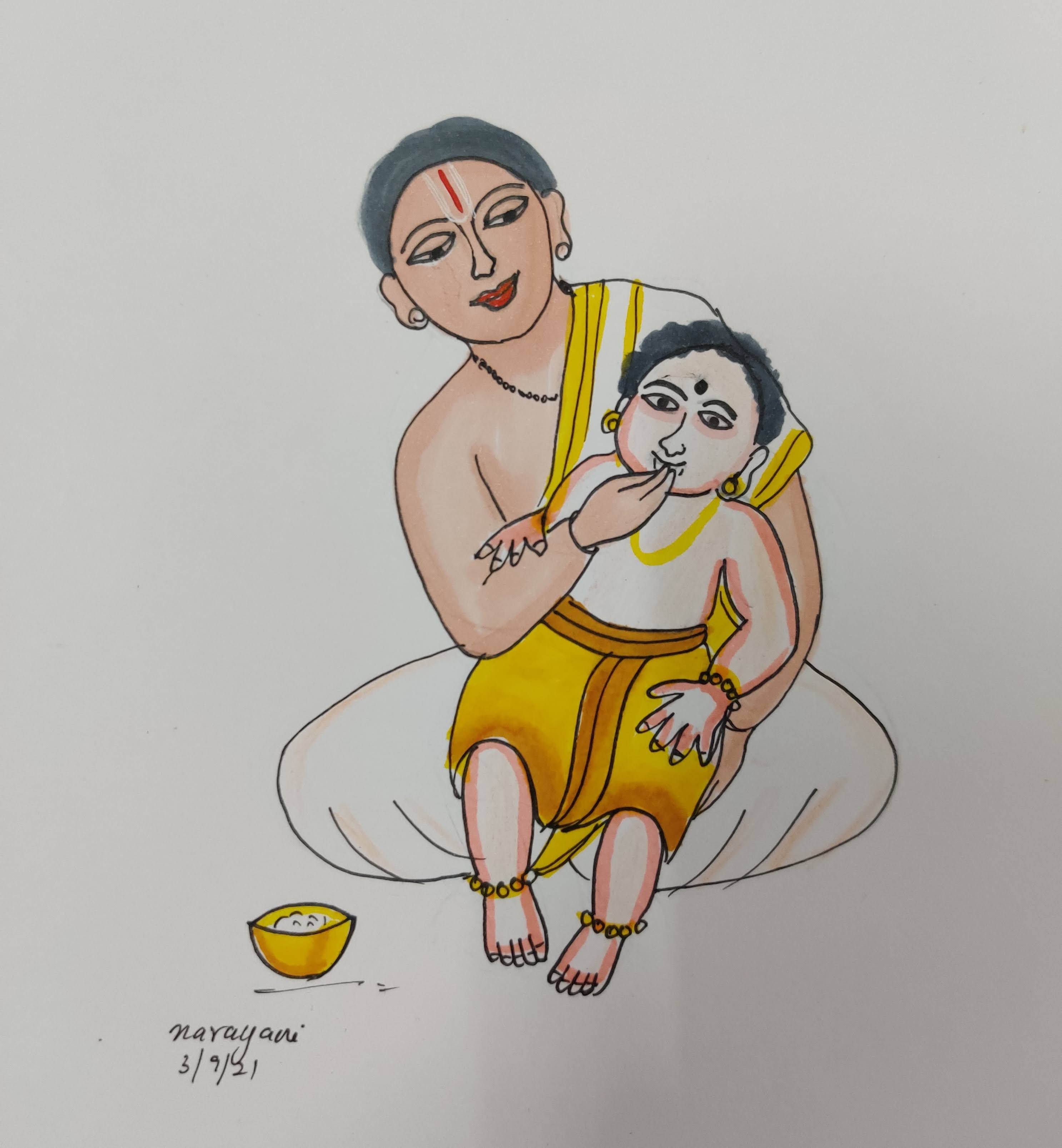List of Samskaaras
स्मार्त कर्मा
पञ्च महा यज्ञ - ५
सप्त पाक यज्ञ - ७
श्रौत कर्मा
सप्त सोम यज्ञ - ७
सप्त हविर यज्ञ - ७
अन्नप्राशन
” अन्नप्राशन annaprAshana ” is the ceremony that marks the child’s first food intake other than milk. Annam means ‘food’ and prAshanam means ‘feeding/eating’. A transition from liquid to solid diet, the child is introduced to cooked rice to support his growth with more nutrition.

“annaprAshanam” is done in the sixth month from the date of birth of the child. It coincides with the teething stage of the child.
Yajur vEda bOdhaayana sootra says in second prashna, third adhyaayaa.
षष्ठे मास्यन्नप्राशनम् ।
“annapraashanam” is performed in the sixth month.
Procedure according to Yajur Veda – Apastamba gruhya sootra Patala 6, khanda 16:
सू. जन्मनोऽधि षष्ठे मासि ब्राह्मणान्भोजयित्वाशिषो वाचयित्वा दधि मधु घृतमोदनमिति संसृज्योत्तरैर्मन्त्रैः कुमारं प्राशयेत् ।
Six months after the child’s birth, the father serves food to BraahmaNaas and gets their blessings. Then he mixes 1. दधि curd, 2. मधु honey, 3. घृत ghee and 4. ओदन cooked rice and feeds the boy while reciting the mantras.
1. An auspicious day is selected by the priest for this samskAra.
2. nitya karmA नित्यकर्मा – In the morning the father (kartA) of the child must perform his sandhyAvandanam and AupAsanam as usual.
3. The priest then arrives and conducts the following:-
4. anugyA अनुज्ञा – The father gives tamboolam ( a tray with betel leaves, betel nuts, saffron and fruits) with dakshiNa (a satisfying sum of money) to brAhmAnas well versed in the vedas and takes “anugyai” (permission and blessing) from them for conducting the ceremony.
5. vigneshwara pooja विग्नेश्वर पूजा – A vigneshwara pooja is performed to receive the blessings of Lord Ganesha.
6. sankalpam सन्कल्पम् – The father undertakes to do this annaprAshana samskAram for his child, specifying the details of cosmic spaces and time, earthly place, season, day, time, gotrA, sharman (name kept at nAmakaraNa ceremony) and astrological details like star, rAsi, etc. of the couple and the child.
7. pratisarabandham or kangaNa dhAraNam प्रतिसरबन्धम् – “pratisara” is a cord or a thread tied around the wrists of the husband and the wife, as a protective band against bad energies. Again brahmaNas recite many sooktas in praise of gAyatree, agni, Apa:, hiraNya, viShNu, Lakshmi etc. to energise the pratisaram. Then it is tied around the right wrist of the husband, the left wrist of the wife and around the wrist of the child (right if boy and left if girl) with special bruhadsAma mantras.
8. abhyudayam or nAndee shrAddham: अभ्युदयम्/नान्दी श्राद्धम् – An “anna roopa nAndee shrAddham” (refer garbhAdhAna for details) is performed to receive the blessings of the nAndee mukha pitrUs.
9. पुण्याहवाचनं puNyAhavAchanam :- A kumbha (water pot) is filled with water and Lord VaruNa invoked. A sankalpa is done with the given name of the child, his star and rAshi again to do “puNyAhavAchanam”. Then “puNyAha” mantrAs are recited for purifying the house and its inmates. Then “swasti vAchana” mantrAs are recited wishing all auspiciousness to the child and the family. The sacred water is sprinkled on the child and the “annam” prepared for the child. The annam is made by mixing 1. दधि curd, 2. मधु honey, 3. घृत ghee and 4. ओदन cooked rice.
10. mantras: The following four vyAhruti mantrAs fromEkAgni kANDam, prashna 2, anuvAka 14, verse 11 are uttered and then the child is fed the purified “annam” from a golden cup or using a golden ring.
1.pÉÔ-UýmÉÉÇ iuÉÉæwÉþkÉÏlÉÉýóèý UxÉÇý mÉëÉzÉþrÉÉÍqÉ ÍzÉýuÉÉxiÉý AÉmÉý AÉãwÉþkÉrÉxxÉliuÉlÉqÉÏýuÉÉxiÉý AÉmÉý AÉãwÉþkÉrÉxxÉliuÉxÉÉæ (name of the child is uttered).
Meaning: First vyAhruti bhoo: (भू: ) Dear child, I feed you with water (आप)) and medicine (ओषधि). May these bring you goodness of health. May they protect you against diseases.
2. pÉÑuÉÉãÅmÉÉÇ iuÉÉæwÉþkÉÏlÉÉýóèý UxÉÇý
mÉëÉzÉþrÉÉÍqÉ ÍzÉýuÉÉxiÉý AÉmÉý
AÉãwÉþkÉrÉxxÉliuÉlÉqÉÏýuÉÉxiÉý AÉmÉý
AÉãwÉþkÉrÉxxÉliuÉxÉÉæ
(name of the child is uttered)
Meaning: Second vyAhruti bhuva: (भुव: ), Dear child, I feed you with water (आप)and medicine(ओषधि). May these bring you goodness of health. May they protect you against diseases.
3. xÉÑuÉUmÉÉÇ iuÉÉæwÉþkÉÏlÉÉýóèý UxÉÇý
mÉëÉzÉþrÉÉÍqÉ ÍzÉýuÉÉxiÉý AÉmÉý
AÉãwÉþkÉrÉxxÉliuÉlÉqÉÏýuÉÉxiÉý AÉmÉý
AÉãwÉþkÉrÉxxÉliuÉxÉÉæ
(name of the child is uttered)
Meaning: Third vyAhruti suva: (सुव: ), Dear child, I feed you with water (आप) and medicine (ओषधि). May these bring you goodness of health. May they protect you against diseases.
4.pÉÔpÉÑïuÉxxÉÑuÉUmÉÉÇ
iuÉÉæwÉþkÉÏlÉÉýóèý UxÉÇý mÉëÉzÉþrÉÉÍqÉ
ÍzÉýuÉÉxiÉý AÉmÉý
AÉãwÉþkÉrÉxxÉliuÉlÉqÉÏýuÉÉxiÉý AÉmÉý
AÉãwÉþkÉrÉxxÉliuÉxÉÉæ
(name of the child is uttered)
Meaning: All 3 vyAhrutis bhoorbhuvassuva: (भूर्भुवस्सुव: ), Dear child, I feed you with water (आप) and medicine (ओषधि). May these bring you goodness of health. May they protect you against diseases.
11. AsheervAdam आशीर्वाद : The child is blessed by all elders.
12. bruhaspati sambhAvana: The priests are seen off with due gifts.
The ceremony like the earlier samskAras is performed at home. But now-a-days this samskAra is also conducted in temples by temple priests.

